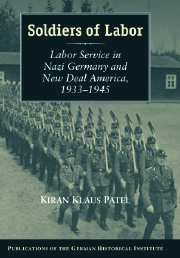Book contents
- Frontmatter
- Introduction
- 1 A Panacea for the Great Depression? Labor Service Ideas and Their Implementation Prior to 1933
- 2 Service to the Community: The Organization of the Labor Services
- 3 “Citizens,” Volksgenossen, and Soldiers: Education in the Labor Services
- 4 In “The Grandeurs of Nature”: The Work of the Labor Services
- Concluding Reflections
- Abbreviations
- Sources and Bibliography
- Index
Concluding Reflections
Published online by Cambridge University Press: 05 January 2013
- Frontmatter
- Introduction
- 1 A Panacea for the Great Depression? Labor Service Ideas and Their Implementation Prior to 1933
- 2 Service to the Community: The Organization of the Labor Services
- 3 “Citizens,” Volksgenossen, and Soldiers: Education in the Labor Services
- 4 In “The Grandeurs of Nature”: The Work of the Labor Services
- Concluding Reflections
- Abbreviations
- Sources and Bibliography
- Index
Summary
Both the German and the American labor services were established as instruments in the battle against youth unemployment. In addition, both had an educational mission. On a sociopsychological level, the two institutions were the result of the enormous pressure under which contemporaries found themselves: the coincidence of accelerating changes in all spheres of life and massive modernization crises in the form of the Great Depression made existing concepts for resolving the crisis, especially free-market ones, appear obsolete. In this situation, labor services became important around the world; in some societies they were even seen as a virtual miracle cure.
But what role did the organizations actually play in the fight against the crisis in Germany and the United States? As I have shown, the two labor services - because of their size, form of financing, project types, labor-intensive deployment, and in the case of the CCC, the vocational training it offered - made no significant contribution to pulling their respective economies out of the great slump. Moreover, for a very long time, both institutions were dominated by the primacy of education, even if the CCC claimed that it was interested primarily in practical work. It was only through massive armament efforts and by transforming themselves into war societies that the two nations were able to overcome the Great Depression. Of course, this formal similarity must not conceal the fact that in Germany this happened as the result of an aggressive policy aimed at a war of racial annihilation, while the United States saw itself forced, rather unwillingly, to pursue armament measures in the face of the approaching storm clouds of war.
- Type
- Chapter
- Information
- Soldiers of LaborLabor Service in Nazi Germany and New Deal America, 1933–1945, pp. 395 - 410Publisher: Cambridge University PressPrint publication year: 2005



